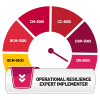Maximum Tolerable Level of Disruption: Difference between revisions
Jump to navigation
Jump to search
No edit summary |
No edit summary |
||
| (2 intermediate revisions by the same user not shown) | |||
| Line 6: | Line 6: | ||
'''Related Terms''': [[Operational Resilience]] , [[Impact Tolerance]], [[Important Business Services]], [[Critical Business Services]], [[Critical Operations]], [[Service Recovery Time Objective]], [[Plausible Scenarios]], [[Severe but Plausible Scenarios]], [[Recovery_Objectives_-_Category|Recovery Objectives]] | |||
'''''Maximum Tolerable Level of Disruption:''''' | |||
'''''Notes (1):''''' is often expressed in factors such as financial loss, operational downtime, reputational damage, regulatory non-compliance, customer dissatisfaction, or other critical business consequences. | |||
'''''Notes (2):''''' helps set boundaries and guide resilience strategies to ensure disruptions remain within acceptable limits. | |||
'''''Reading for OR Course Participant:''''' | |||
'''''Notes (1):''''' [https://blog.bcm-institute.org/operational-resilience/impact-tolerance-vs-mtld-vs-mtpd Impact Tolerance Vs Maximum Tolerable Level of Disruption (MTLD) Vs Maximum Time Period of Disruption (MTPD)] | |||
'''''Notes (2):''''' [https://blog.bcm-institute.org/operational-resilience/impact-tolerance-and-recovery-time-objective Impact Tolerance Vs Recovery Time Objective] | |||
'''Related Terms''': [[Operational Resilience]] , [[Impact Tolerance]], [[Important Business Services]], [[Critical Business Services]], [[Critical Operations]], [[Service Recovery Time Objective]], [[Plausible Scenarios]], [[Severe but Plausible Scenarios]], [[Recovery_Objectives_-_Category|Recovery Objectives]] | |||
<br><br> | <br><br> | ||
Latest revision as of 12:39, 12 October 2024



